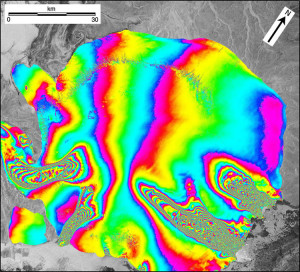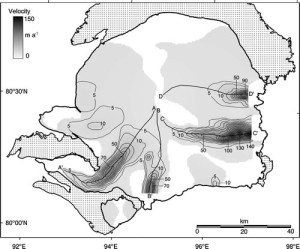Large ice caps dynamics and mass balance
There is over 600,000 km2 of glacier ice outside the great ice sheets of Antarctica and Greenland (Dyurgerov and Meier, 1997). This ice is distributed among both relatively large ice caps of 103 to 104 km2, and very large numbers of smaller glaciers. The bulk of the ice volume is contained in the large ice caps which reach up to about 1000 m in thickness, and are typically drained by fast-flowing ice streams or outlet glaciers. Examples include the ice caps on Ellesmere and Devon islands in the Canadian High Arctic (covering almost 100,000 km2), the larger ice caps on Svalbard and the Russian Arctic islands (e.g. Austfonna in eastern Svalbard at 8,200 km2 and 560 m thick; Academy of Sciences Ice Cap in Severnaya Zemlya at 5,500 km2 and 700 m thick), the extensive ice sheet in Patagonian South America, and the ice caps of intermediate size beyond the margins of the Greenland Ice Sheet. Many of these ice caps have margins ending in the ocean, but the rates of mass loss through the production of icebergs, although likely to be significant for overall mass balance, have seldom been investigated.
Fig. 1. SAR interferorgram of the Academy of Sciences Ice Cap, Russian High Arctic, in the slant-range geometry of the ERS satellite. The pair of SAR images were acquired on 23 and 24 September 1995, during the ERS Tandem Phase. The interferometric parallel baseline between the two satellite locations is 1 m. The ramp across the interferogram has been removed during subsequent processing. The interferogram of the ice cap is superimposed on a Landsat image of the surrounding terrain and marine waters. (From Dowdeswell et al., In Press).
These ice caps are in many cases more sensitive to environmental change than the great ice sheets, for two reasons. First, they are smaller by several orders of magnitude, and this means that they take a significantly shorter time to respond to a given climatic perturbation than the great ice sheets (Johannesson et al., 1989). Secondly, many of them are located in areas with significantly higher mass turnover than the great ice sheets, and some are in areas proposed to be especially likely, according to GCM predictions (e.g. Cattle and Crossley, 1995), to exhibit amplified climate change in a warming World (e.g. the Arctic in general and the Norwegian-Greenland Sea area in particular). In addition, a number of drainage basins within these ice caps are known to have exhibited intermittent surging (Dowdeswell et al., 1999), with its associated implications for ice mass stability.
Fig. 2. Corrected interferometrically-derived ice-surface velocities (vcorr) for the Academy of Sciences Ice Cap, after phase unwrapping and the removal of topographic effects in the 23-24 September 1995 pair of ERS Tandem-Phase scenes. The first two contours are at velocities of 5 and 10 m yr-1, with subsequent contours at 10 m yr-1 intervals. Unshaded areas on the ice cap are regions of no vcorr data. A correction from look-direction velocities (vlook) to velocity in the direction of maximum ice flow (assumed to be parallel to the angle of maximum ice-surface slope) has been made. Stippled areas are bare land. (From Dowdeswell et al., In Press).
The changing dimensions, dynamics and mass balance of these large ice caps are thus significant to our understanding of broader issues such as (a) rising global sea level, (b) the flux of icebergs and glacial meltwater into high-latitude seas, and (c) ice mass instability. Specific objectives for this project include:
- Measure ice cap velocities using InSAR and, together with our ice-penetrating radar data on ice thickness, calculate iceberg calving rates, which are the least well-known element in the mass balance of Arctic ice caps. (See Figures 1 and 2 for results from the Academy of Sciences Ice Cap).
- Model the flow dynamics of Arctic ice caps using numerical ice-sheet models, and predict likely responses to future climate change.
References
Cattle, H. and Crossley, J., Modelling Arctic climate change. Philosophical Transactions of the Royal Society, London, Series A, 352, 201-213.
Dowdeswell, J.A., Unwin, B., Nuttall, A.-M. and Wingham, D.J., 1999. Velocity structure, flow instability and mass flux on a large Arctic ice cap from satellite radar interferometry. Earth and Planetary Science Letters, 167, 131-140.
Dowdeswell, J.A., Bassford, R.P., Gorman, M.R., Williams, M., Glazovsky, A.F., Macheret, Y.Y., Shepherd, A.P., Vasilenko, Y.V., Savatyuguin, L.M., Hubberten, H.-W. and Miller, H., In Press. Form and flow of the Academy of Sciences Ice Cap, Severnaya Zemlya, Russian High Arctic. Journal of Geophysical Research.
Dyurgerov, M.B. and Meier, M.F., 1997. Mass balance of mountain and subpolar glaciers: a new global assessment for 1961-1990. Arctic and Alpine Research, 29, 379-391.
Johannesson, T., Raymond, C.F., and Waddington, E., 1989. Time-scale for adjustment of glaciers to changes in mass balance. Journal of Glaciology, 35, 355-369.


